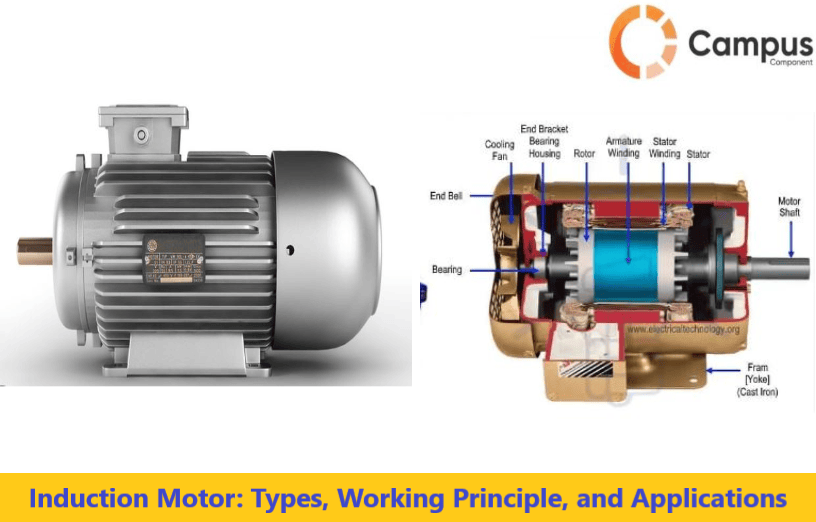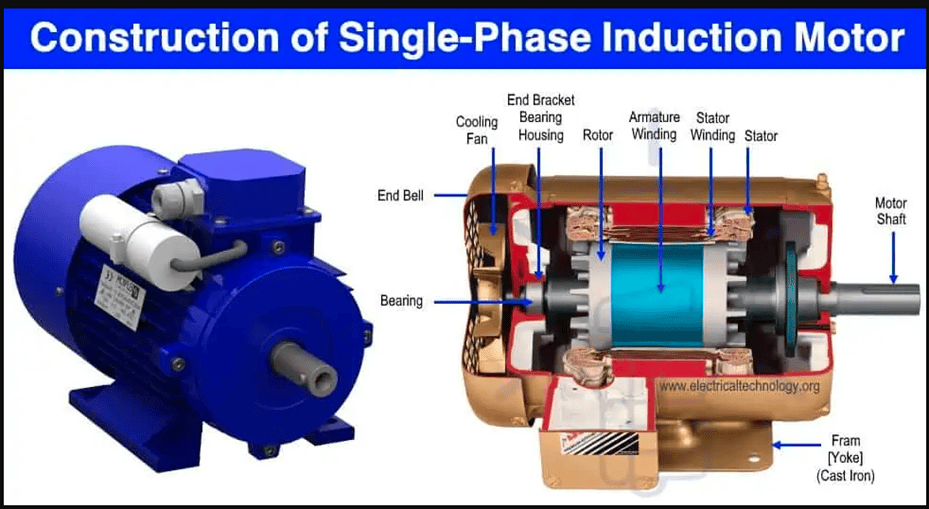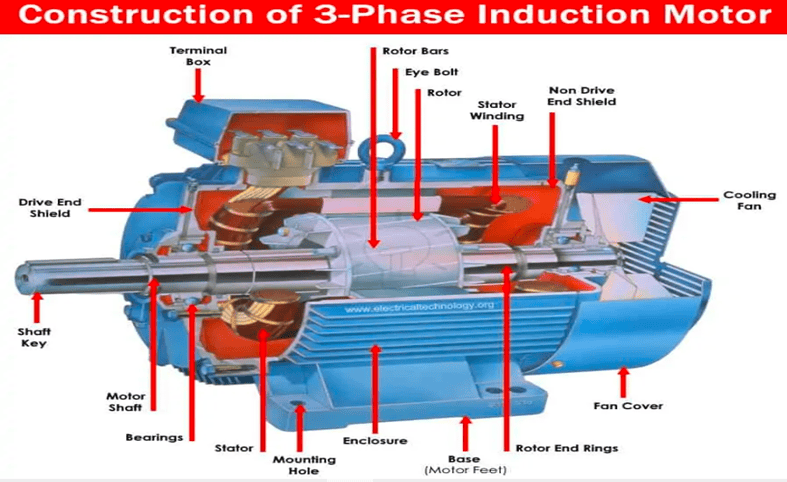
Induction Motors: An Overview
Induction motors are one of the most widely used types of electrical machines in industries and households. They works on the principle of electromagnetic induction. Unlike other motors, induction motors do not require a direct electrical connection between the stator (stationary part) and the rotor (rotating part). This unique construction allows for reliable operation and minimal maintenance.
Types of Induction Motors
1. Single-Phase Induction Motor
Single-phase induction motors are commonly used in household appliances such as fans, refrigerators, and washing machines. They require only one phase of power supply and are typically used for smaller loads. However, single-phase induction motors are not self-starting, so they require an auxiliary mechanism like a starting capacitor or a split-phase to initiate motion.

Construction of Single-Phase Induction Motor
Single phase induction motor constructed in two main parts
1) Stator:
The stator is the stationary part of the motor, and it has a core made of laminated steel to reduce energy losses. Inside the stator, there are copper windings where the alternating current (AC) flows. These windings are responsible for creating the magnetic field needed to make the rotor spin. Some motors also have an auxiliary winding or a capacitor connected to the stator to help the motor start.
2) Rotor:
The rotor is the part that rotates. It’s usually a squirrel cage design, meaning it has bars made of copper or aluminum connected at the ends by rings. These bars form a closed loop. When the magnetic field from the stator interacts with the rotor, it induces a current in these bars, which causes the rotor to spin. The motor also includes a shaft connected to the rotor, bearings to support the shaft and allow it to rotate smoothly, and a frame to hold everything together.
Working Principle of Single Phase Induction Motor
A single-phase induction motor works by converting electrical energy into mechanical energy using electromagnetic induction. It has a stator, which is the stationary part, and a rotor, which rotates. When a single-phase AC supply is given to the stator winding, it creates a pulsating magnetic field.
This field alone cannot produce enough torque to start the motor, so an auxiliary winding or capacitor is used to create a phase difference, producing a rotating magnetic field. This rotating field induces a current in the rotor, which generates its own magnetic field. The interaction between the rotor’s magnetic field and the stator’s field causes the rotor to turn, resulting in motor rotation. Once the motor reaches a certain speed, the auxiliary winding may be disconnected, and the motor continues to run using the main winding.
2. Three-Phase Induction Motor
Three-phase induction motors are used in industrial applications due to their efficiency and higher power capacity. These motors are self-starting, unlike single-phase motors, because they produce a naturally rotating magnetic field when powered by three-phase AC.

Construction of Three-Phase Induction Motor
The construction of a three-phase induction motor is similar in many ways to a single-phase induction motor, but there are some key differences.
1. Stator:
Like the single-phase motor, the stator of a three-phase induction motor is made up of laminated steel with copper windings. However, instead of just one winding (or two in some cases for starting), the stator of a three-phase motor has three separate windings.
These windings are spaced 120 degrees apart and are powered by a three-phase AC supply. This setup creates a naturally rotating magnetic field, which makes the motor self-starting without the need for an auxiliary winding or capacitor like in single-phase motors.
2. Rotor:
Both motors use a similar squirrel cage rotor, with bars of aluminum or copper connected at the ends by rings. When the magnetic field from the stator interacts with the rotor, it induces a current in these bars, which generates torque and causes the rotor to spin. In this way, the rotor construction is largely the same between both types of motors.
3. Self-Starting:
A major difference between the two is that a single-phase motor typically needs a starting mechanism (like an auxiliary winding or capacitor) to initiate rotation, because its magnetic field is not rotating by itself. In contrast, a three-phase motor naturally creates a rotating magnetic field due to the three-phase power supply, so it starts automatically and more smoothly.
Working Principle of Three-Phase Induction Motor
A three-phase induction motor works by using three-phase alternating current (AC) to produce a rotating magnetic field, which causes the rotor to spin and generate mechanical energy. The stator, the stationary part of the motor, has three sets of windings spaced 120 degrees apart. When a three-phase AC supply is applied, it creates a rotating magnetic field around the stator. This rotating field moves at a certain speed, called synchronous speed.
The rotor, typically a squirrel cage design made of copper or aluminum bars, is placed inside this rotating field. As the magnetic field rotates, it induces an electric current in the rotor bars, which generates its own magnetic field.
The interaction between the stator’s rotating magnetic field and the rotor’s magnetic field creates a torque, causing the rotor to turn. The rotor always lags slightly behind the stator's rotating field, which is why it operates at a slightly lower speed than synchronous speed. This process allows the motor to efficiently convert electrical energy into mechanical motion without needing additional starting components.
Induction Motor Vs Synchronous Motor
Feature | Induction Motor | Synchronous Motor |
Speed | Varies with load (not constant) | Constant Speed (synchronous speed) |
Self -Starting | Yes(three phase ) , No (Single Phase ) | No( Requires external starting device ) |
Efficiency | Generally lower than synchronous motor | Higher efficiency for the Same rating |
Power factor | Lower , due to lagging power factor | Better power factor , near unity |
Rotor Type | Squirrel cage or wound rotor | Electromagnetic rotor |
Slip | Exists (rotor speed < synchronous speed) | No slip (rotor speed = synchronous speed) |
What is Slip in Induction Motor?
The difference between the synchronous speed of the rotating magnetic field in the stator and the actual speed of the rotor is called Slip.
Slip(S) = (Synchronous speed – Rotor Speed / Synchronous speed ) * 100
Slip is crucial because it determines the amount of torque generated in the motor. In a typical induction motor, slip is small but necessary for torque production.
Use of Starter In Induction Motor
Induction motors draw a high starting current, sometimes up to 6-7 times their rated current. This excessive current can cause voltage drops in the supply system, affecting other electronic components and potentially damaging the motor winding due to overheating.
To mitigate this, a starter is used to gradually increase the motor's speed and limit the starting current. Starters like Direct-On-Line (DOL), Star-Delta, and auto-transformers are commonly used based on the motor’s rating and application.
Starting Current of Induction Motor
When an induction motor is started, the rotor is stationary, meaning there is a large difference between the synchronous speed and the rotor speed, leading to maximum slip. This high slip induces a large current in the rotor and, subsequently, a large current is drawn from the supply. As the motor reaches its operating speed, the slip decreases, and so does the current.
Synchronous Speed in Induction Motors
It is the theoretical speed at which the magnetic field generated by the stator rotates. It depends on the number of poles in the motor and the supply frequency.
Synchronous speed = 120 x f / p
Where, f = frequency in Hz
p = number of poles in the motor
Advantages of Induction Motors
· Simplicity and Durability: Induction motors have fewer moving parts, making them highly reliable and easy to maintain.
· Cost-effective: They are relatively inexpensive due to their simple design.
· High Efficiency: These motors are highly efficient, especially in three-phase designs, making them ideal for industrial applications.
· Robust Construction: They are known for their ability to withstand harsh operating conditions, making them perfect for heavy-duty tasks.
Applications of Induction Motors
Induction motors are found in a wide variety of applications:
· Industrial machinery such as conveyor belts, compressors, and elevators.
· Household appliances like washing machines, air conditioners, and refrigerators.
· HVAC systems that rely on induction motors for fans and pumps.
· Electric vehicles (EVs) where induction motors are often used due to their high torque and efficiency.
Challenges and Limitations of Induction Motor
While induction motors are highly versatile, they do come with some challenges:
· Starting Torque: Single-phase induction motors often have low starting torque, requiring external mechanisms for efficient starting.
· Speed Control: Induction motors have limited speed control, which can be a drawback in applications requiring variable speeds.
· Energy Losses: Induction motors experience some energy losses due to slip and rotor resistance, though this is minimized in modern designs.
Conclusion
Induction motors are a cornerstone of electrical machinery due to their simplicity, durability, and cost-effectiveness. Whether single-phase or three-phase, these motors serve a variety of applications, from household gadgets to heavy industrial machinery.
Understanding key concepts like slip, synchronous speed, and the need for a starter can help in optimizing their performance for different applications. By comparing them with synchronous motors, we see the trade-offs between constant-speed operation and simplicity, making induction motors the go-to choice for most variable-speed applications.
